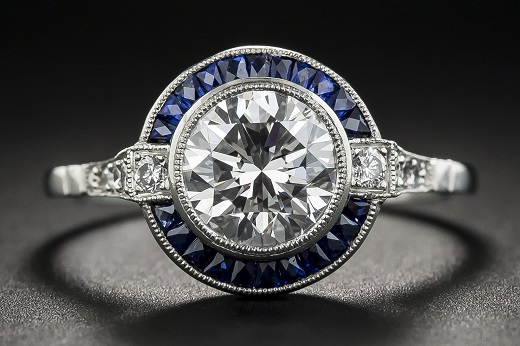|
|
The Keys to Dating a Diamond Ring
Dec 30, 2019 10:27 AM
By Phyllis Schiller
|
|
|

RAPAPORT... Suzanne Martinez, co-owner of Lang Antiques in San Francisco, explains how to distinguish the real from the repro.
How difficult is it to date diamond rings?
As with all types of forensic work, one clue is not conclusive. It is not unusual to find original Art Deco rings set with earlier diamond cuts that were remounted as styles changed. With careful examination, a circa date — plus or minus 10 years — can be determined. The key is to compare motifs, materials, and methods of manufacture.
What are the most challenging periods and cuts to identify?
The hardest are transitional pieces, produced over a period of time, marrying characteristics of older and newer styles. The lacy, delicate bows and garlands of Edwardian motifs transitioned into Art Deco styles in the 1920s, becoming very architectural by the late 1930s. Art Deco-style rings from the 1950s can be recognized by the fishtail settings and baguettes set in a channel rather than the earlier style of metal on all four sides. Art Deco is the most popular style for reproductions. Art Deco includes filigree, decorative and simple solitaires with all cuts of stones. This period has influenced new jewelry as well.
What are the telltale signs of an antique diamond ring replica?
Most European-cut melee from the 1920s and ’30s has a closed culet that comes to a point. New European cuts are very calibrated and typically have large, open culets centered under the table, and thick girdles. Old diamonds aren’t perfect; from one star facet to the next, there is a little variation, something you can see with a loupe.
Edwardian rings are all hand-fabricated. Art Deco rings are hand-fabricated and die-struck predominantly. Later cast rings are heavier, with more metal. A die-struck ring has a seam; the inside metal has a flat surface. An older repaired or rhodium-plated ring might have more metal, making it harder to determine whether or not the piece was cast. One sign of casting, and most likely a reproduction, is the presence of tiny gas bubbles trapped in the mold when it was cast.
Do you have any other useful info for retailers new to antique jewelry?
Edwardian rings were either platinum over gold, at the beginning, or all platinum. If it’s white gold, it is not Edwardian. In the Art Deco period, you have 18-karat white gold and platinum. Also, the cleverest reproductions are cast using an original Deco ring for the mold. One giveaway is if the diamonds don’t fit perfectly, as they would in an authentic ring. It is not unusual for reproductions and poorly restored rings to have exaggerated or heavier-grained milgraining. They can be rough to the touch. True vintage rings usually have finer milgraining, which might still be intact, or the milgraining has wear so the texture of the milgraining is not so distinct. They can be soft or smooth to the touch.
Suzanne Martinez is co-owner of Lang Antiques. She is an accredited senior
gemologist, a jewelry appraiser and jewelry historian, as well as the founder
of the Antique Jewelry University website.
This article was first published in the November issue of Rapaport Magazine.
Image: A sapphire and diamond reproduction ring in the Art Deco style. (Lang Antiques & Estate Jewelry)
|
|
|
|
|
|
|
|
|
|
Tags:
antique jewelry, Antique Jewelry University, Art Deco, Edwardian, Estate jewelry, estate jewels, European cut, gold, Lang Antiques, milgraining, Phyllis Schiller, platinum, Rapaport News, san francisco, Suzanne Martinez
|
|
|
|
|
|
|
|
|
|
|

|
|